
Probability Fundamentals 🎲
MATH 4720/MSSC 5720 Introduction to Statistics
Department of Mathematical and Statistical Sciences
Marquette University
Language of Uncertainty
Probability Fundamentals
Interpretation
Operations
Conditional Probability
Independence
Bayes Formula
Why Study Probability
- We live in a world full of chances and uncertainty!
Sep 13, 2025
Sep 19, 2022
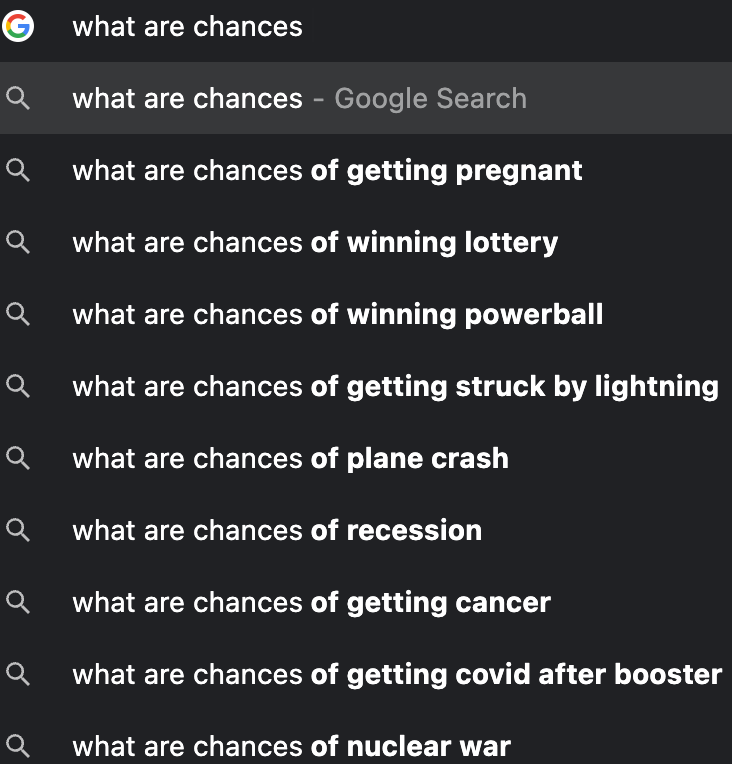
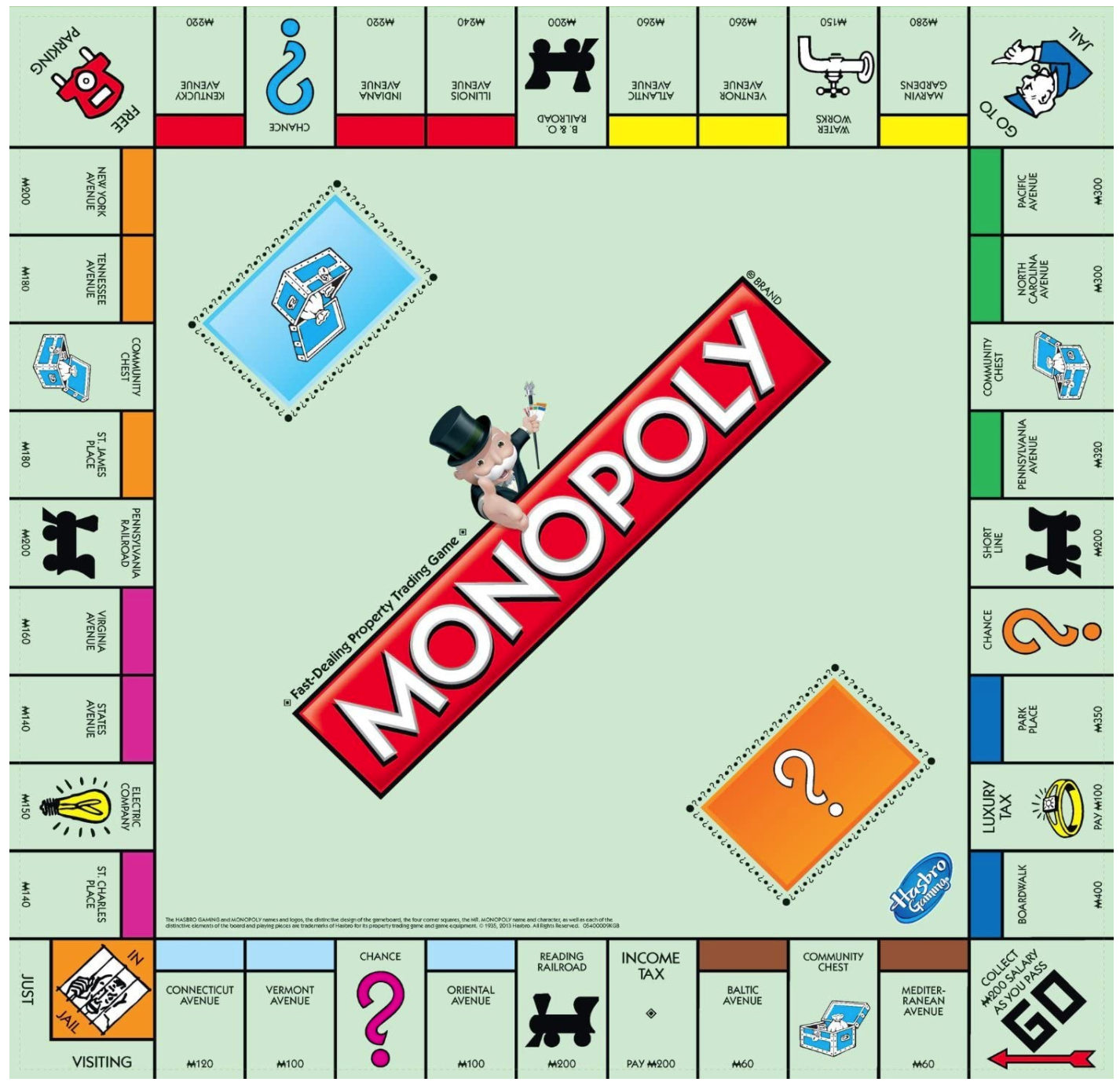

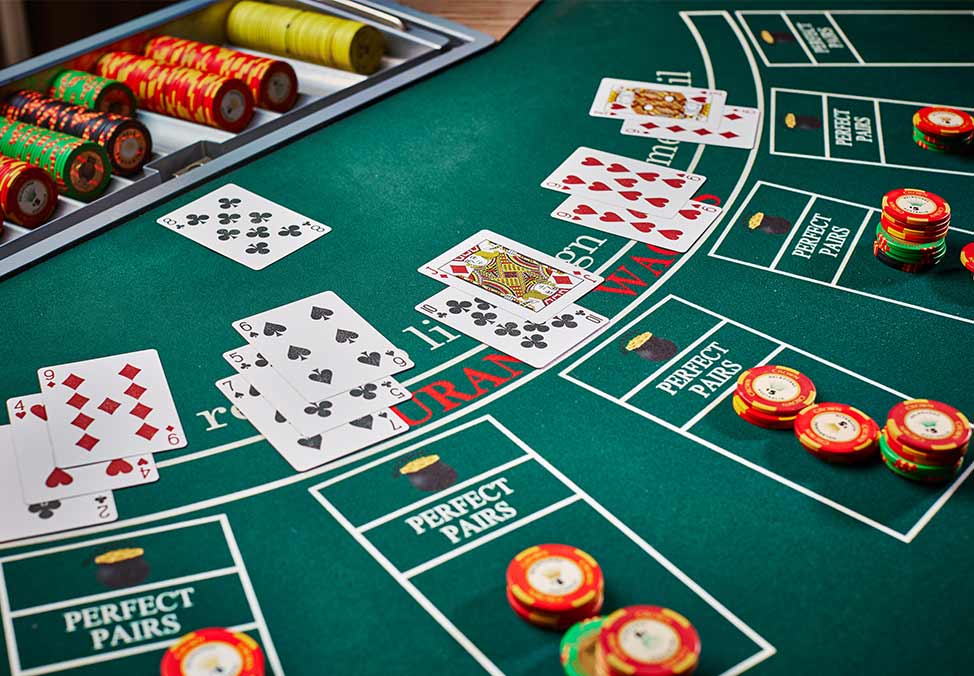
Why Probability Before Statistics?
Probability : We know the process generating the data and are interested in properties of observations.
Statistics : We observed the data (sample) and are interested in determining what is the process generating the data (population).

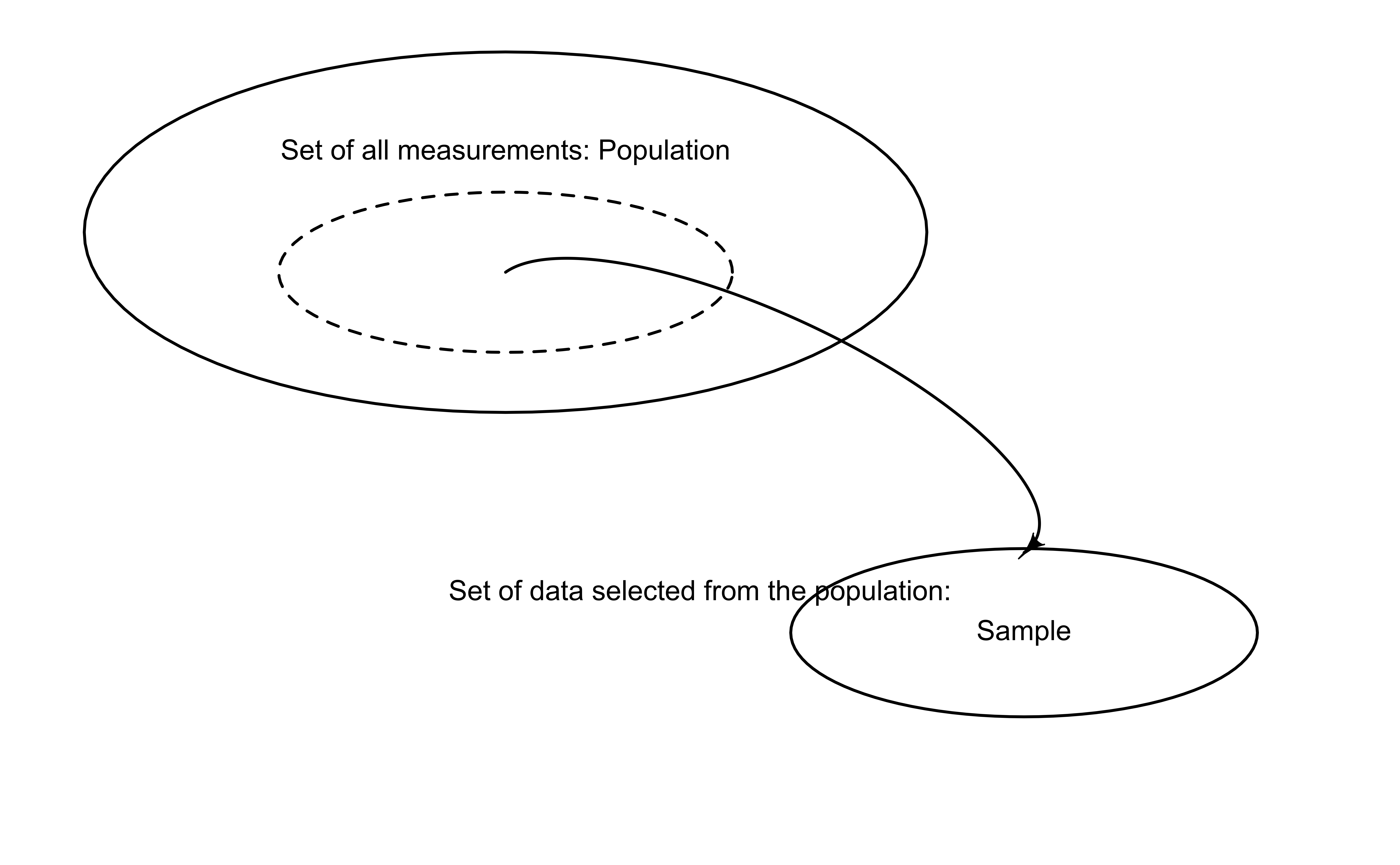
Interpretation of Probability
Interpretation of Probability: Relative Frequency
- Relative Frequency : The probability that some outcome of a process will be obtained is interpreted as the relative frequency with which that outcome would be obtained if the process were repeated a large number of times independently under similar conditions.
Frequency Relative Frequency
Heads 1 0.1
Tails 9 0.9
Total 10 1.0
---------------------
Frequency Relative Frequency
Heads 515 0.515
Tails 485 0.485
Total 1000 1.000
---------------------If we repeat tossing the coin 10 times, the probability of obtaining heads is 10%.
If 1000 times, the probability is 51.5%.
Any issue of relative frequency probability?
Issues of Relative Frequency
- 😕 How large of a number is large enough?
- 😕 Meaning of “under similar conditions”
- 😕 The relative frequency is reliable under identical conditions?
- 👉 We only obtain an approximation instead of exact value.
- 😂 How do you compute the probability that Chicago Cubs wins the World Series next year?

Interpretation of Probability: Classical Approach
Classical probability : The probability is based on the concept of equally likely outcomes.
If the outcome of some process must be one of \(n\) different outcomes, the probability of each outcome is \(1/n\).
- Example:
- toss a fair coin (2 outcomes) 🪙
- roll a well-balanced die (6 outcomes) 🎲
- draw one from a deck of cards (52 outcomes) 🃏
Any issue of classical probability?
- The probability that [you name it] wins the World Series next year is 1/30?!

Interpretation of Probability: Subjective Approach
Subjective probability : The probability is assigned or estimated using people’s knowledge, beliefs and information about the data generating process.
A person’s subjective probability of an outcome, rather than the true probability of that outcome.
- I think “the probability that Milwaukee Brewers wins the World Series this year is 30%”.
- My probability that Milwaukee Brewers wins the World Series next year is different from an ESPN MLB analyst’s probability.


Any probability operations and rules do NOT depend on interpretation of probability!
Probability Operations and Rules
Experiments, Events and Sample Space
Experiment: any process in which the possible outcomes can be identified ahead of time.
Event: a set of possible outcomes of the experiment.
Sample space \((\mathcal{S})\) of an experiment: the collection of ALL possible outcomes of the experiment.
| Experiment | Possible Outcomes | Some Events | Sample Space |
|---|---|---|---|
| Flip a coin 🪙 | Heads, Tails | {Heads}, {Heads, Tails}, … | {Heads, Tails} |
| Roll a die 🎲 | 1, 2, 3, 4, 5, 6 | {1, 3, 5}, {2, 4, 6}, {2}, {3, 4, 5, 6}, … | {1, 2, 3, 4, 5, 6} |
Is the sample space also an event?
- Yes, the sample space itself is an event because it is also a set of possible outcomes of the experiment.
Set Concept: Example of Rolling a six-side balanced die
Draw a Venn Diagram every time you get stuck!
-
Complement of an event (set) \(A\), \(A^c\) : a set of all outcomes (elements) of \(\mathcal{S}\) in which \(A\) does not occur.
- Let \(A\) be an event that a number greater than 2. Then \(A = \{3, 4, 5, 6\}\) and \(A^c = \{1, 2\}\).
-
Union \((A \cup B)\) : a set of all outcomes of \(\mathcal{S}\) in \(A\) or \(B\).
- Let \(B\) be an event that an even number is obtained. (What is \(B\) in terms of a set?)
- \(B = \{2, 4, 6\}\), \(A \cup B = \{2, 3, 4, 5, 6\}\).
-
Intersection \((A \cap B)\) : a set of all outcomes of \(\mathcal{S}\) in both \(A\) and \(B\).
- \(A \cap B = \{4, 6\}\).
Set Concept: Example of Rolling a six-side balanced die
-
\(A\) and \(B\) are disjoint (or mutually exclusive) if they have no outcomes in common \((A \cap B = \emptyset)\).
- \(\emptyset\) means an empty set, \(\{\}\), i.e., no elements in the set.
- Let \(C\) be an event that an odd number is obtained. Then \(C = \{1, 3, 5\}\) and \(B \cap C = \emptyset\).
-
Containment \((A \subset B)\): every elements of \(A\) also belongs to \(B\). If \(A\) occurs then so does \(B\).
- \(B\) is an event that an even number is obtained.
- \(D\) is an event that a number greater than 1 is obtained.
- \(B = \{2, 4, 6\}\) and \(D = \{2, 3, 4, 5, 6\}\).

\(B \subset D\) or \(D \subset B\)?
Probability Rules
Denote the probability of an event \(A\) on a sample space \(\mathcal{S}\) as \(P(A)\).
Treat the probability of an event as the area of the event in the Venn diagram.
-
Axioms
- \(P(\mathcal{S}) = 1\)
- For any event \(A\), \(P(A) \ge 0\)
- If \(A\) and \(B\) are disjoint, \(P(A \cup B) = P(A) + P(B)\)
-
Properties
- \(P(\emptyset) = 0\).
- \(0 \le P(A) \le 1\)
- \(P(A^c) = 1 - P(A)\)
- \(P(A \cup B) = P(A) + P(B) - P(A \cap B)\) (Addition Rule)
- If \(A \subset B\), then \(P(A) \le P(B)\)
Venn Diagram Illustration
- Addition Rule: \(P(A \cup B) = P(A) + P(B) - P(A \cap B)\)

- Disjoint case: \(P(A \cup B) = P(A) + P(B)\) because \(P(A \cap B) = 0\)!

Example: M&M Colors
The makers of the candy M&Ms report that their plain M&Ms are composed of
- 15% Yellow; 10% Red; 20% Orange; 25% Blue; 15% Green; 15% Brown
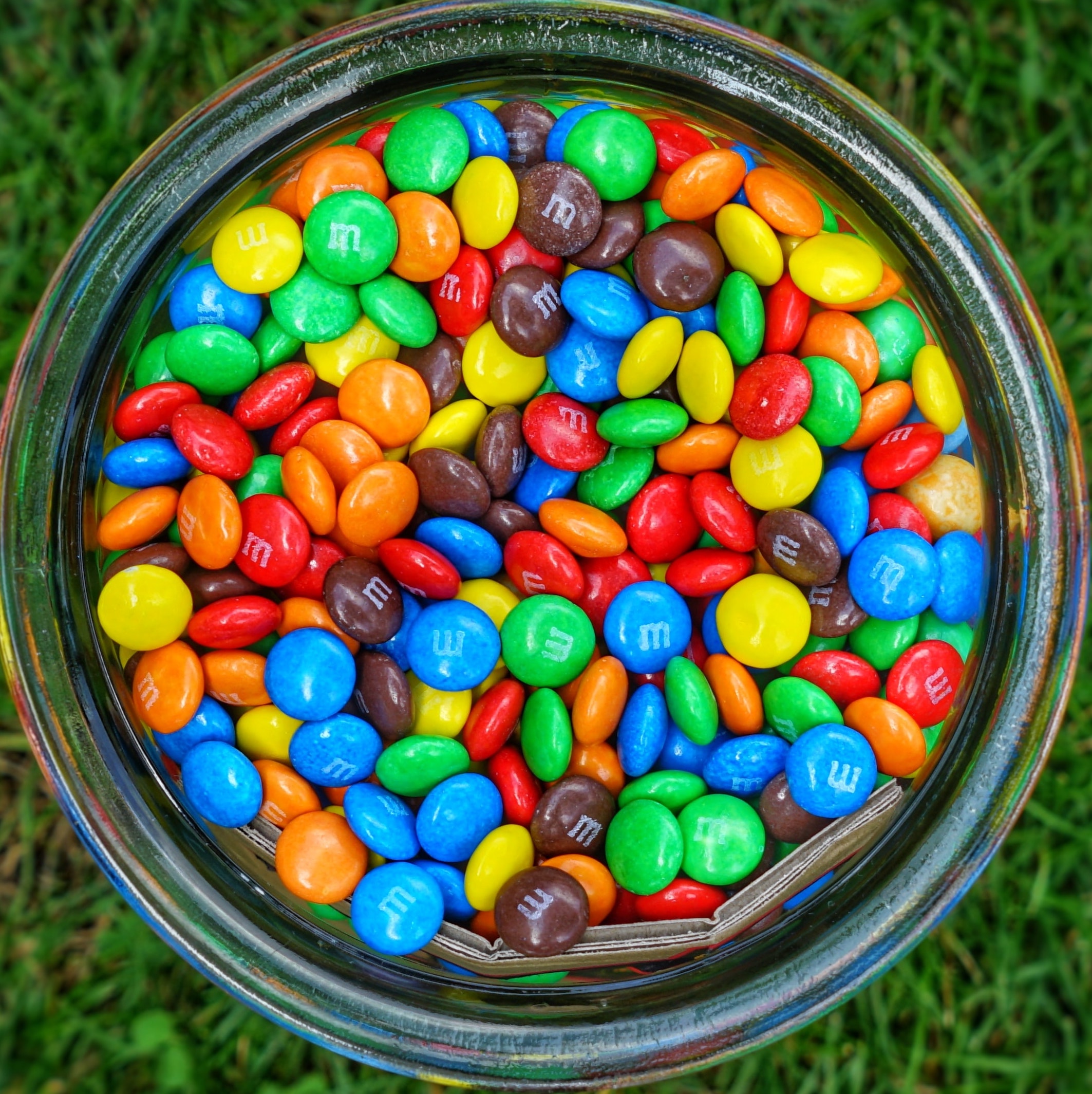
If you randomly select an M&M, what is the probability of the following?
- It is brown.
- It is red or green.
- It is not blue.
- It is red and brown.
02:00
Example: M&M Colors
- 15% Yellow; 10% Red; 20% Orange; 25% Blue; 15% Green; 15% Brown
If you randomly select an M&M, what is the probability of the following?
- It is brown.
- It is red or green.
- It is not blue.
- It is red and brown.
\(P(\mathrm{Brown}) = 0.15\)
\(\small \begin{align} P(\mathrm{Red} \cup \mathrm{Green}) &= P(\mathrm{Red}) + P(\mathrm{Green}) - P(\mathrm{Red} \cap \mathrm{Green}) \\ &= 0.10 + 0.15 - 0 = 0.25 \end{align}\)
\(P(\text{Not Blue}) = 1 - P(\text{Blue}) = 1 - 0.25 = 0.75\)
\(P(\text{Red and Brown}) = P(\emptyset) = 0\)
By the way, which interpretation of probability is used in this question?
Conditional Probability and Independence
Conditional Probability
- The conditional probability of \(A\) given \(B\) is
\[ P(A \mid B) = \frac{P(A \cap B)}{P(B)} \] if \(P(B) > 0\), and it is undefined if \(P(B) = 0\).
- “Given \(B\)” means that event \(B\) has already occurred.

Multiplication Rule: \(P(A \cap B) = P(A \mid B)P(B) = P(B \mid A)P(A)\)
\(P(A)\) and \(P(B)\) are unconditional or marginal probabilities.
Difference Between \(P(A)\) and \(P(A \mid B)\)
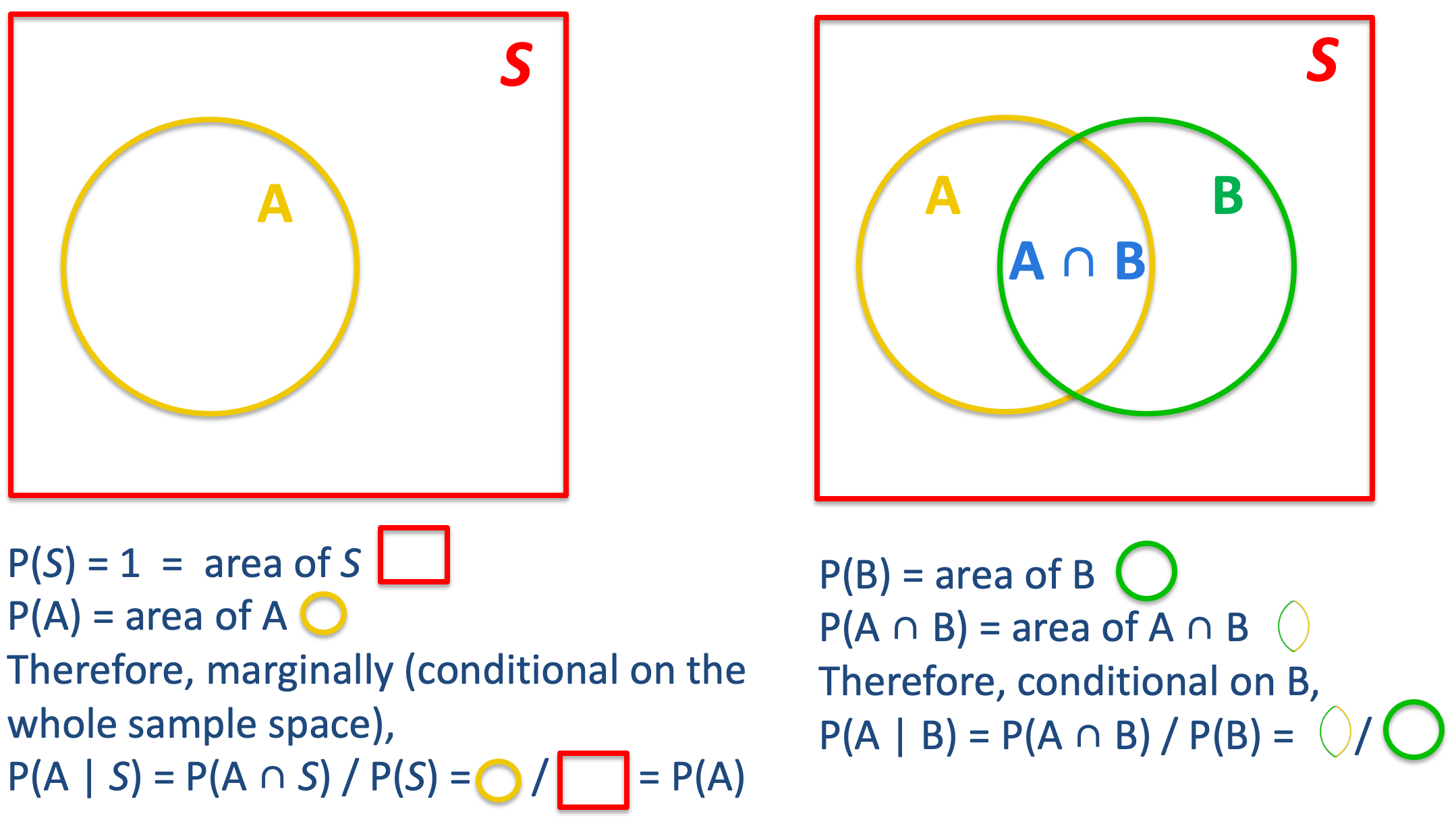
Example: Peanut Butter and Jelly
Suppose 80% of people like peanut butter, 89% like jelly, and 78% like both.
Given that a randomly sampled person likes peanut butter, what’s the probability that she also likes jelly?
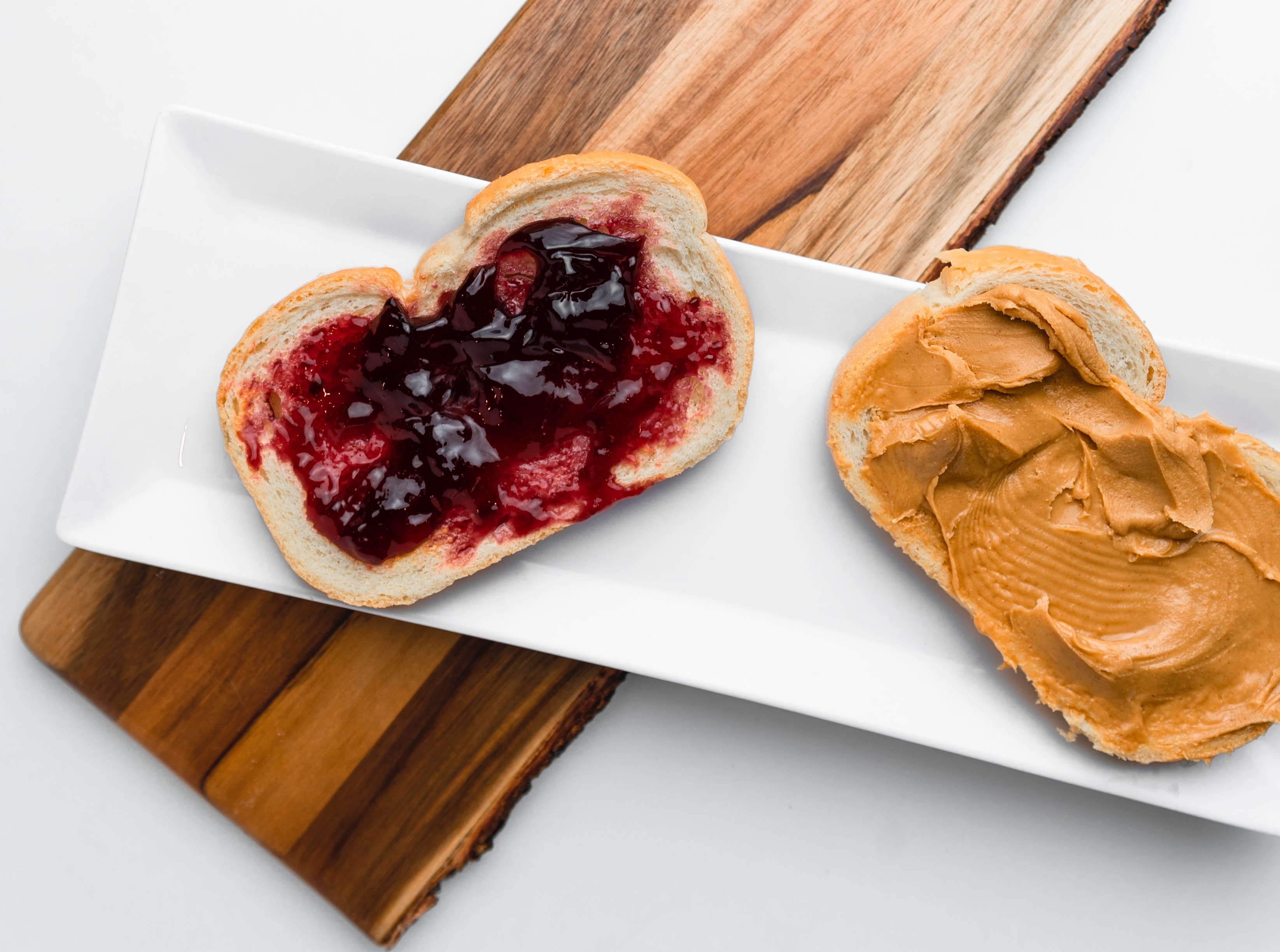
We want \(P(J\mid PB) = \frac{P(PB \cap J)}{P(PB)}\).
From the problem we have \(P(PB) = 0.8\), \(P(J) = 0.89\), \(P(PB \cap J) = 0.78\)
\(P(J\mid PB) = \frac{P(PB \cap J)}{P(PB)} = \frac{0.78}{0.8} = 0.975\).
If we don’t know if the person loves peanut butter, the probability that she loves jelly is 89%.
If we do know she loves peanut butter, the probability that she loves jelly is going up to 97.5%.
Independence
\(A\) and \(B\) are independent if \(\begin{align} P(A \mid B) &= P(A) \text{ or }\\ P(B \mid A) &= P(B) \text{ or } \\P(A\cap B) &= P(A)P(B)\end{align}\) \(\text{ if } P(A) > 0 \text{ and } P(B) > 0\)
Intuition: Knowing \(B\) occurs does not change the probability that \(A\) occurs, and vice versa.
Can we compute \(P(A \cap B)\) if we only know \(P(A)\) and \(P(B)\)?
No, we cannot compute \(P(A \cap B)\) since we do not know if \(A\) and \(B\) are independent.
We could only if \(A\) and \(B\) were independent.
In general, we need the multiplication rule \(P(A \cap B) = P(A \mid B)P(B)\).
Venn Diagram Explanation of Independence
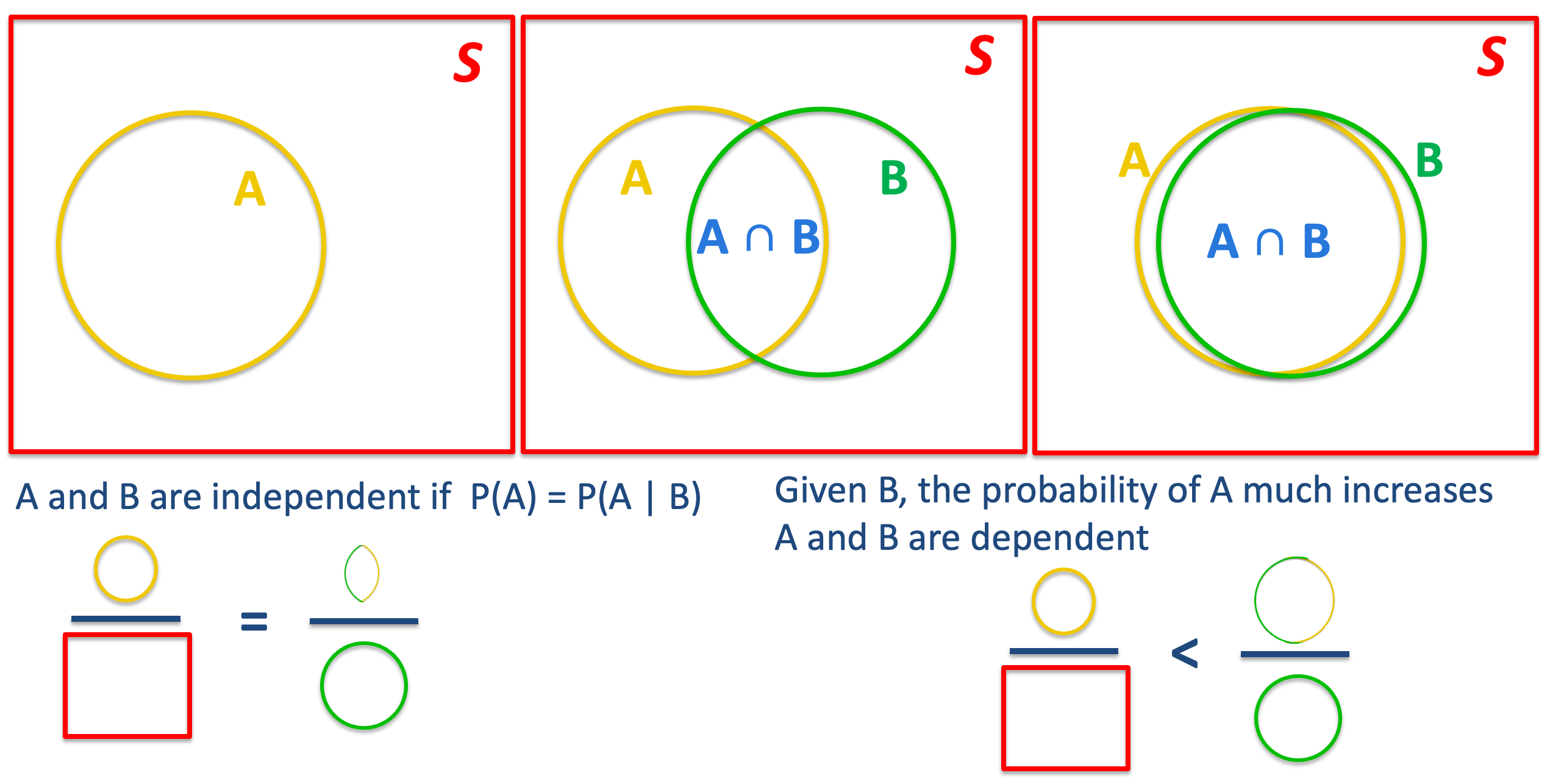
Independence Example
- Assuming that events \(A\) and \(B\) are independent. \(P(A) = 0.3\) and \(P(B) = 0.7\).
- \(P(A \cap B)\)?
- \(P(A \cup B)\)?
- \(P(A \mid B)\)?
02:00
- \(P(A \cap B) = P(A)P(B)=0.21\)
- \(P(A \cup B) = P(A)+P(B)-P(A\cap B) = 0.3+0.7-0.21=0.79\)
- \(P(A \mid B) = P(A) = 0.3\)
Bayes’ Formula
Why Bayes’ Formula?
Often, we know \(P(B \mid A)\) but are much more interested in \(P(A \mid B)\).
Example: diagnostic tests provide \(P(\text{positive test result} \mid \text{COVID})\), but we are interested in \(P(\text{COVID} \mid \text{positive test result})\)
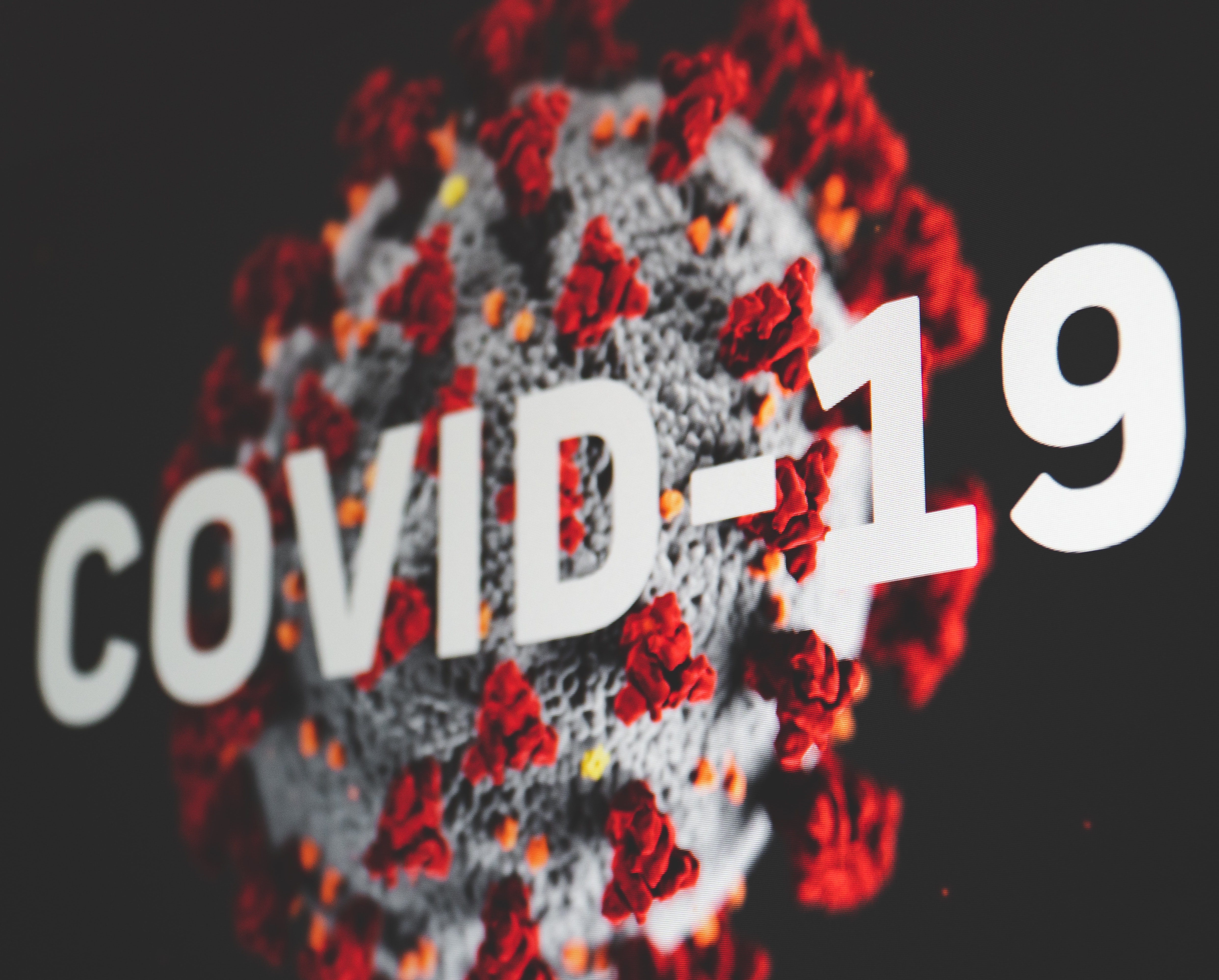
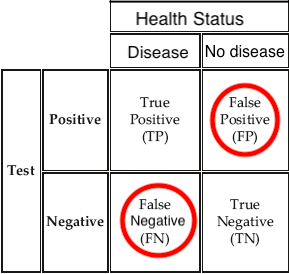
- Bayes’ formula provides a way for finding \(P(A \mid B)\) from \(P(B \mid A)\)
Bayes’ Formula
- If \(A\) and \(B\) are any events whose probabilities are not 0 or 1, then
\[\begin{align*} P(A \mid B) &= \frac{P(A \cap B)}{P(B)} \quad ( \text{def. of cond. prob.}) \\ &= \frac{P(A \cap B)}{P((B \cap A) \cup (B \cap A^c))} \quad ( \text{partition } B) \\ &= \frac{P(B \mid A)P(A)}{P(B \mid A)P(A) + P(B \mid A^c)P(A^c)} \quad ( \text{multiplication rule}) \end{align*}\]

Example: Passing Rate
After taking MATH 4720, \(80\%\) of students understand the Bayes’ formula.
- Of those who understand the Bayes’ formula,
- \(95\%\) passed
- Of those who do not understand the Bayes’ formula,
- \(60\%\) passed

Calculate the probability that a student understand the Bayes’ formula given the fact that she passed.
Bayes Formula: Step-by-Step
\(80\%\) of students understand the Bayes’ formula.
Of those who understand the Bayes’ formula, \(95\%\) passed ( \(5\%\) failed).
Of those who do not understand the formula, \(60\%\) passed ( \(40\%\) failed).
\[P(A \mid B) = \frac{P(B \mid A)P(A)}{P(B \mid A)P(A) + P(B \mid A^c)P(A^c)}\]
- Step 1: Formulate what we would like to compute
\(P(\text{understand} \mid \text{passed})\)
- Step 2: Define relevant events in the formula: \(A\), \(A^c\) and \(B\)
Let \(A =\) understand. \(B =\) passed. Then \(A^c =\) don’t understand and \(P(\text{understand} \mid \text{passed}) = P(A \mid B)\).
Bayes Formula: Step-by-Step
\(80\%\) of students understand the Bayes’ formula.
Of those who understand the Bayes’ formula, \(95\%\) passed ( \(5\%\) failed).
Of those who do not understand the formula, \(60\%\) passed ( \(40\%\) failed).
\[P(A \mid B) = \frac{P(B \mid A)P(A)}{P(B \mid A)P(A) + P(B \mid A^c)P(A^c)}\]
- Step 3: Find probabilities in the Bayes’ formula using provided information.
\(P(B \mid A) = P(\text{passed} \mid \text{understand}) = 0.95\), \(P(B \mid A^c) = P(\text{passed} \mid \text{don't understand}) = 0.6\)
\(P(A) = P(\text{understand}) = 0.8\), \(P(A^c) = 1 - P(A) = 0.2\).
- Step 4: Apply Bayes’ formula.
\(P(\text{understand} \mid \text{passed}) = P(A \mid B) = \frac{P(B \mid A)P(A)}{P(B \mid A)P(A) + P(B \mid A^c)P(A^c)} = \frac{(0.95)(0.8)}{(0.95)(0.8) + (0.6)(0.2)} = 0.86\)
Bayes Formula: Tree Diagram Illustration
\(80\%\) of students understand the Bayes’ formula.
Of those who understand the Bayes’ formula, \(95\%\) passed ( \(5\%\) failed).
Of those who do not understand the formula, \(60\%\) passed ( \(40\%\) failed).
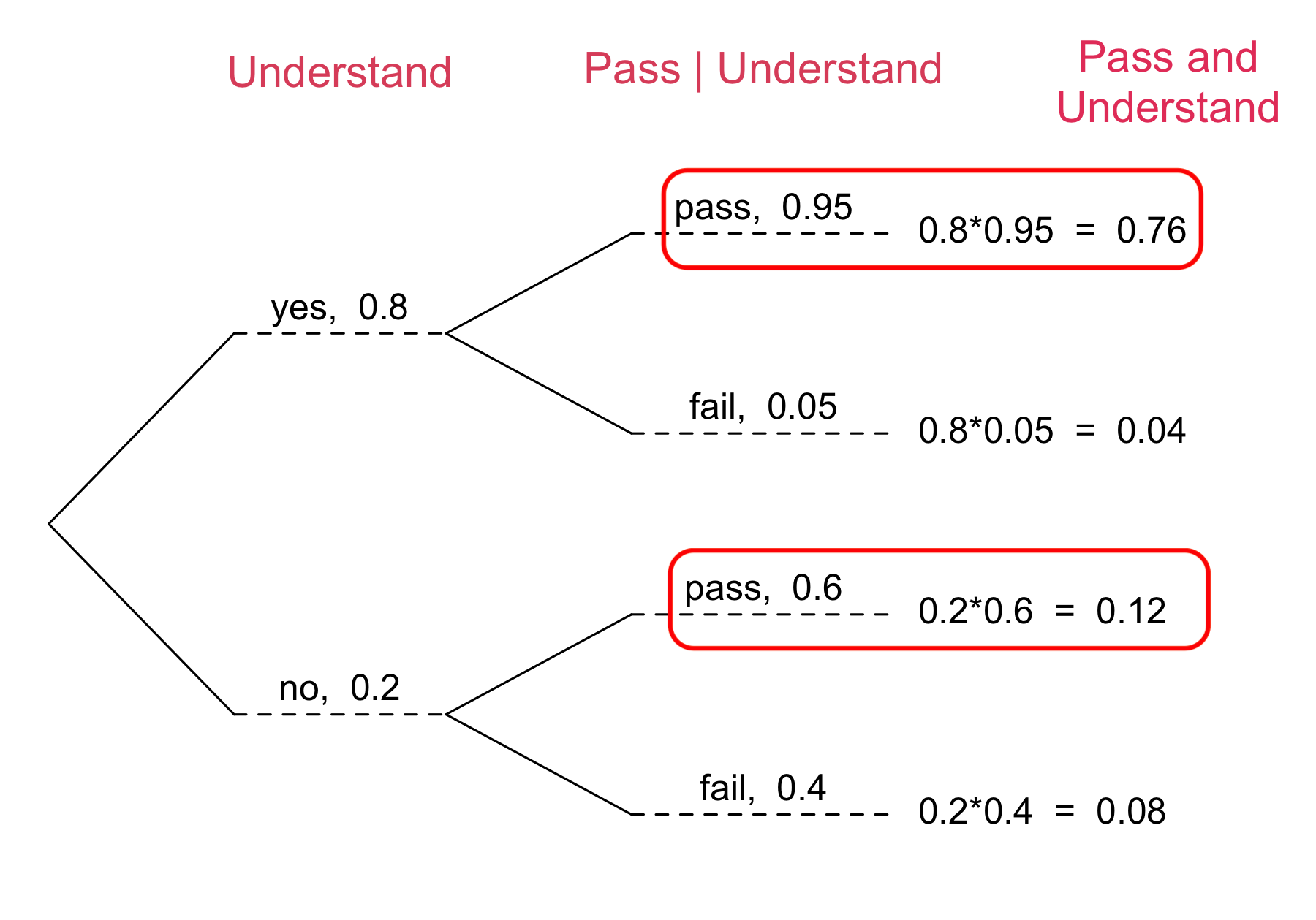
\[\begin{align*} & P(\text{yes} \mid \text{pass}) \\ &= \frac{P(\text{yes and } \text{pass})}{P(\text{pass})} \\ &= \frac{P(\text{yes and } \text{pass})}{P(\text{pass and yes}) + P(\text{pass and no})}\\ &= \frac{0.76}{0.76 + 0.12} = 0.86 \end{align*}\]